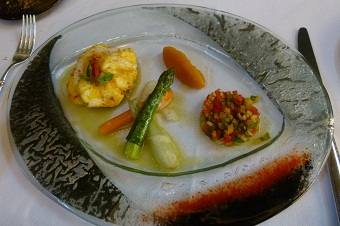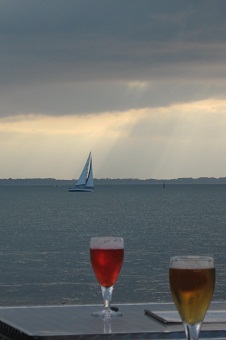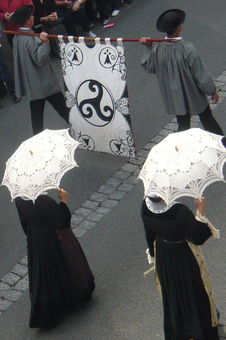Here are a few notes about culture and daily life in France and in Brittany in particular. You may already know about "French art of living" and culture. But what about Breton culture ?
Bretagne is a French province, as any other province like Normandy, Provence or Burgundy. France and Brittany have had the same fate for about five centuries, but if you look closely, you will notice many details expressing Breton specificity. But don't worry, in Brittany like everywhere else in France, you will find some wine, cheese and croissants!
Gastronomy
To pique your interest and work up an appetite, here is a non exhaustive list of examples of Breton specialities :
- Breton wafers ("galettes") which base is buckwheat, will be on menu in the pancakes restaurants called "crêperies". Its dough will be slightly different depending on the area you are. In Lower Brittany, the Breton wafer is often called sarrasin flour crêpe ("crêpe de blé noir"). It is served with traditional ingredients such as egg, cheese, ham, bacon, tomato, andouille sausage. But you will also find them sometimes revisited by the chef with salted and sugar taste, sea fruits, veggies and spices, etc.
- The wheat pancake "crepe" is the traditional dessert after you had a galette. Imagination is almost limitless to find ingredients to go with it : jams, honey, hot chocolate, caramel with salted butter, salidou, fruits, ice-cream, chantilly cream, or flambée pancake…
- Our region is also ideal if you want to go for a good seafood platter, with crustaceans, oysters or mussels. Muscadet wines from Nantes vineyards will be the ideal wine to go with them.
- Fishing in the neighborhood make it possible to have great dishes with fresh fish in many restaurants. These will have been nicely prepared (bass, pike, cod, sea bream, mullet, yellowtail, sardines, hake, …).
- And for your sweet tooth, you will be able to taste caramel made of salted butter, kouign aman, Pont Aven biscuits, Berlingots, and Rigolettes…
- Cider will be the ideal drink companion when you have a meal in a crêperie. You will have to choose from the hard apple cider or soft version (maybe you will be explained that the raw version is the real one). You can now find many good farm produced ciders.
- Breton breweries are making a successful comeback these days. They have quality and tasty beers on offer : Coreff, Lancelot, Dremmwel, Duchess Anne, Sainte Colombe, Britt, Telenn Du …
 |
 |
Music and dance
Music has a very special place in the Britton culture. Whether it is traditional or modern (from rock to reggae but also punk), combining sometimes biniou (Breton bagpipe), bombarde, accordion, harp and singing, there are plenty of occasions to hear it and enjoy.
Breton dancing is not left aside. You will be able to observe and practice should you wish to do so, during one of the so many fest-noz festivals.
Symbols
Marks of Breton and celtic culture remain very present nowadays, and withyour eyes open many of them are easy to glimpse.
Among these symbols, you will undoubtedly notice the Breton flag, which is called gwenn ha du ("white and black" in Breton). Its nine strips represent old bishoprics: 4 bishoprics in white for the western part of Brittany, 5 bishoprics in black for the eastern part. In the upper-left corner are a few ermine marks. You can find these marks in many places, on buildings for example, as well as fleur-de-lis identified French royalty. The white fur of ermine reminds purity. The ermine is sometimes straight represented on coat of arms (for instance for Vannes). A legend tells that duchess Anne de Bretagne noticed the grace and the courage of the ermine refusing to get dirty though some hunters were on its footsteps. A motto was kept : "Death rather than soiling".
On this land of legends and belief many other symbols appear during strolls, including old and modern ones, from triskell and celtic cross till funny Bigouden people drawn at the back of cars.
 |
 |
Language
We should speak of languages actually, because breton (britton) and gallo are recognized as languages in Brittany.
Breton is a celtic language, it was traditionally more spoken on the western side of a Saint-Brieuc / Vannes virtual line, whereas gallo was on the eastern side (in ancient times though breton was spoken until the area of Rennes). These areas correspond more or less to Lower and Upper Brittany.
Breton language was long neglected and even at risk of extinction. Nowadays it gets back on track to a certain extent, in Lower as well as in Upper Brittany. Its teaching is growing.
Gallo is a romance language. But it has not taken advantage yet of the same recognition and support than the breton language against the risk of extinction.




